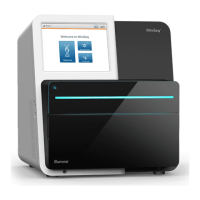For 2-channel analysis, RTA2 uses a population-based system to determine the chastity of a base call.
Clusters pass filter (PF) when no more than 1 base call in the first 25 cycles has an unacceptable chastity
value. Clusters that do not pass filter are not base called in future cycles.
Indexing Considerations
The process for base calling index reads differs from base calling during other reads.
Index reads must begin with at least 1 base other than G in either of the first 2 cycles. If an Index Read begins
with 2 base calls of G, no signal intensity is generated. Signal must be present in either of the first 2 cycles to
ensure demultiplexing performance.
To increase demultiplexing robustness, select index sequences that provide signal in at least 1 channel,
preferably both channels, for every cycle. Following this guideline avoids index combinations that result in only
G bases at any cycle.
u Red channel—A or C
u Green channel—A or T
This base calling process ensures accuracy when analyzing low-plex samples.
Quality Scoring
A quality score, or Q-score, is a prediction of the probability of an incorrect base call. A higher Q-score
implies that a base call is higher quality and more likely to be correct.
The Q-score is a compact way to communicate small error probabilities. Q(X) represents quality scores,
where Xis the score. The following table shows the relationship between the quality score and error
probability.
Q-Score Q(X) Error Probability
Q40 0.0001 (1 in 10,000)
Q30 0.001 (1 in 1,000)
Q20 0.01 (1 in 100)
Q10 0.1 (1 in 10)
NOTE
Quality scoring is based on a modified version of the Phred algorithm.
Quality scoring calculates a set of predictors for each base call, and then uses the predictor values to look up
the Q-score in a quality table. Quality tables are created to provide optimally accurate quality predictions for
runs generated by a specific configuration of sequencing platform and version of chemistry.
After the Q-score is determined, results are recorded in the base call files.
Document # 1000000002695 v02 Material # 20014309
For Research Use Only. Not for use in diagnostic procedures.
51
MiniSeq System Guide

